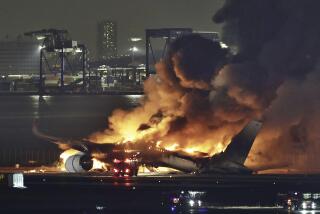Prepared Passengers Minimize Safety Risk
- Share via
While most frequent travelers are aware that flying is one of the safest modes of travel, they are often unaware that there are some things they can do to increase their survivability in the unlikely event they are involved in an airplane accident.
An increasing number of businesses that have frequent fliers are recognizing this and beginning to take extra steps to prepare their employees, said Linda Pearson, president of Safeair Services based in Irving, Tex. Pearson, a former flight attendant, conducts seminars on passenger safety for corporations such as Arco Oil, J.C. Penney, Texas Instruments, AAA Insurance, Burlington Northern and Monsanto.
The seminars teach safety tips that go beyond the basic information available to passengers when they board a plane, she said. In addition, participants go through drills to prepare them to react quickly in an emergency.
The likelihood of being in an airline accident is remote. In 1992, for example, the rate of fatal accidents was .052 per 100,000 departures.
In 1991, there were 22,215 fatalities involving passenger cars and only 49 deaths involving commercial airlines.
However, there is a reason for the increased interest in passenger safety training. “Aircraft are much safer than they were 20 years ago,” said Matt McCormick, chief of the survival factors division of the National Transportation Safety Board in Washington.
Aircraft manufacturers have incorporated many safety features, ranging from special floor lighting to help lead passengers to exits to automatic fire extinguishers in the lavatories. As a result, more people are likely to survive a crash, McCormick said.
The next critical step is being able to get out of the plane safely. This fact was brought home tragically in February, 1991, when a commercial airliner ran into a commuter jet on the runway at Los Angeles International Airport. Twenty-two of the 89 people on board the larger aircraft died in the accident. Of those who did not survive, 19 were out of their seats, which implied they had survived the initial impact, said NTSB spokesman Ted Lopatakiewicz.
This is why it’s so important to think in advance about how you would get out of the plane, Pearson said. And frequent travelers, many of whom are business travelers, are particularly at risk because they feel as if they already know the information, she said. “But they may not know the type of aircraft they’re on, and the doors may operate differently.”
Also, many people forget that the flight attendants, who are trained to evacuate the aircraft in the event of an emergency, may be knocked out, injured or killed in that emergency, Pearson said.
Here are some safety tips from Pearson, the National Transportation Safety Board and the Federal Aviation Administration that can help maximize survivability after a crash. Some of this information is contained in the safety materials found in airline seat backs.
* Wear natural fibers. Synthetic fibers, including nylon stockings, will melt if there is intense heat. The more tightly woven the fabric the better, since it will slow down any burning and give your body some protection.
* Wear comfortable clothing. Pants are better than skirts for women since they are less apt to impede movement and they protect legs from heat and friction burns. Wear leather-soled, tie-on shoes. No high-heels, “flip-flop” sandals or slip-ons that could come off easily or otherwise interfere with your movement.
* Know what model plane you’re on. Note how its doors operate.
* Count the seat rows. Know how far you are from both your nearest front and back exits. “In an emergency, people’s first instinct is to try to go back out the way they came in,” Pearson said. But that’s not always the best way out.
* Practice buckling and unbuckling your seat belt. It buckles differently than a car belt, and you want to be able to release it without fumbling.
* Be aware of other passengers. Note anyone around you who might need assistance or could impede an evacuation.
* Practice getting into a brace position. Get in a low tuck with your hands under your legs. “Your objective is to keep your body from flailing,” Pearson said. If you brace yourself by crossing your arms and grabbing the seat in front of you, make sure you don’t lock your elbows, she said.
* Always wear your seat belt. Without a belt on, any sudden descent or unforeseen turbulence could throw you against the ceiling or knock you against the walls.
* Don’t let kids play on the floor. The NTSB recommends using child safety seats for children under 2, although that is not currently mandated by the Federal Aviation Administration.
* Take off your glasses during takeoff and landing. This applies to sunglasses too.
* Never put a heavy object in the bin over your head.
* Don’t put hazardous materials in your baggage. Federal regulations forbid this. Some common items banned by the FAA include Mace, aerosols, fireworks, flares, safety or “strike-anywhere” matches, as well as lighter refills.
The point of thinking through these matters in advance is to let you be in control of your situation during an emergency. If you aren’t prepared, shock is more likely to paralyze you.
“It’s like learning CPR or defensive driving,” Pearson said. “The point (of practice) is to get your reactive skills up.”
For more information, contact Safeair at (800) 388-1821.
More to Read
Sign up for The Wild
We’ll help you find the best places to hike, bike and run, as well as the perfect silent spots for meditation and yoga.
You may occasionally receive promotional content from the Los Angeles Times.






